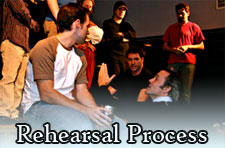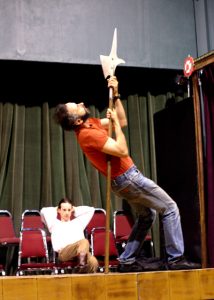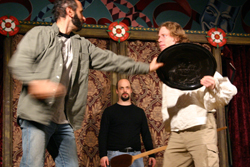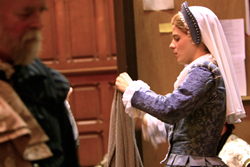
The Rehearsal Process
Introduction

The approximation of the rehearsal and performance conditions likely faced by the original Queen’s Men was central to the SQM project. In this module you can access interviews with the actors and the director, describing and analyzing their experience of the experiment.
Evidence about early modern rehearsal suggests that the Queen’s Men’s approach to preparing a play for performance would have been strikingly different from modern rehearsal practice. The actors worked more independently, and plays were prepared for performance more quickly with very little time spent working together as an ensemble. Since our actors were not accustomed to working in this manner, the SQM rehearsal process was designed to reflect the current understanding of Elizabethan practice but also to give our modern actors time to adapt to now unfamiliar rehearsal techniques.
Like the Queen’s Men our actors worked from ‘parts’ while in the rehearsal room, but because this technique was new to them they had copies of the entire plays for reference when at home. The actors responded in a variety of ways to this rehearsal methodology and opinion was divided on how working with actor’s ‘parts’ affected their approach to performance.
The more experienced actors in the company were designated ‘master actors’ and they were granted authority in the rehearsal room. Directing fellow actors is strongly discouraged in modern theatre practice and our master actors had to learn how to direct from within their scenes without causing offence. There were no directors in early modern theatre but the original players were familiar with the language of the plays, the rehearsal techniques and their own cultural context. Our actors did not have that advantage and the SQM ‘director’ played an important facilitating role, giving advice on theatrical and cultural contexts and the meaning of lines.
The company had to be capable of performing the plays in a variety of venues and stage configurations while on tour without additional rehearsal. This was extremely challenging for actors, who had to develop flexible blocking techniques in order to be able to adjust to changing performance conditions. The company worked quickly by modern standards, preparing three plays for performance in the space of 7 weeks and the increased time pressure forced our actors to find new, efficient ways to prepare the plays for performance.
In keeping with our understanding of early modern theatre practice, the company did not run the plays in their entirety before the first trial performances and these performances were nerve-wracking affairs. The addition of a visible and interactive audience had a profound effect on the actors and was a key factor in bringing the plays to life.
The Shakespeare and the Queen’s Men project combined the skills and expertise of academics and theatre practitioners, enabling us all to learn from each other. Observing this process in action allowed the research team to examine and compare modern and early modern approaches to rehearsal. The actors in turn drew their own lessons from the research experiment.
The SQM Process

1. Renaissance Boot Camp
The original Queen’s Men approached a new play with a shared cultural heritage and a familiarity with their own working practices. We know that members of the original company were also musicians, singers, dancers and (in some cases) expert fencers. We tried to rectify our actors’ obvious knowledge and skill gap by beginning our process with what became known as a Renaissance Boot Camp. The actors were taught songs to sing, learned traditional dances, practiced sword fighting, and were given instruction in the physical comportment befitting the nobility of the day. Those playing women were taught how to stand, sit and hold themselves like a lady and tried on petticoats and corsets to give them a sense of how such clothes constrained movement. Actors were also given a player’s handbook, which introduced them to the social and political contexts of plays and players and encouraged them to apply this knowledge to the development of their performances. After an initial three days of intensive boot camp we started working on King Leir but each day would begin with singing, dancing and sword-fighting.

2. Playwright’s Reading
For the first two plays, in the absence of the playwrights, our director/facilitator read the plays to the company. For the third play, Friar Bacon and Friar Bungay, the company read through the play together.
3. Simultaneous Rehearsal
Unlike the original company, our actors assembled each day for rehearsal in a shared rehearsal space. Because it was not necessary for the director/facilitator to be present at every rehearsal, we were able to schedule rehearsals simultaneously, which enabled a speedier preparation of the play. Each scene rehearsal was led by a master actor and the director/facilitator moved from group to group giving advice on the cultural context and Elizabethan theatrical practice where necessary.
4. Working with ‘Parts’
In keeping with our understanding of original practice, we divided the plays into ‘parts’ for each actor. The actors were also given a copy of the complete play for reference at home to compensate for the fact that they were not familiar with this working practice.
5. Rehearsal Period
For each play, we had only between 7 and 9 days rehearsal. By modern standards, this is an incredibly short time. The actors had to work extremely hard, learning lines as they tackled the complex text and figured out possible blocking for their scenes, in addition to their continuing work on the songs, fights and dances
6. The “First” Full Cast Rehearsal
We had four hours for final preparations in the afternoon before each play’s first public performance. Although all the scenes had been rehearsed individually, we had never run them together. We used this group rehearsal time to work on the larger scenes involving furniture and props, and on fight scenes. Where possible we practiced any quick costume changes we had anticipated. Once that was done we ran as much of the play as we could in sequence before time ran out.
7. The Trial Performance
For Famous Victories, we were able to get through a run of the entire play before the evening performance, but this was not the case for the other two plays, and the trial performance really was the first time the company performed those plays from beginning to end.
The Plot of the Play
The ‘plot’ or ‘platt’ of a play is a fascinating part of the early modern rehearsal process. The image to the right is the plot of the Second Part of the Seven Deadly Sins; the SQM ‘plots’ are available in our production resources section. The ‘plot’ records the entrances of all the characters onto the stage. English scenes are marked with lines across the play but the scenes are not numbered. Often, although not consistently, the names of the actors are recorded next to character name, or at times actor’s names are used instead of the character’s name. Several of the surviving ‘plots’ have a rectangular hole at the top that is about the size of a wooden peg and it is commonly presumed that the ‘plot’ of the play was hung backstage for easy reference during the performance.
The actors’ ‘parts’ contain all their lines and cues but not their entrances or any sense of where their scenes come in the order of the play. They would have some sense of this from the playwright’s reading and the company reading, but on the day of rehearsal they would need to know the exact timing of the scenes and especially their entrances. The ‘plot’ was prepared by the company book-keeper who was also likely the prompter for the performance and the person responsible for getting the actors onstage at the appropriate time.
In the SQM experiment we underestimated the importance of the ‘plot’ and the role of the prompter in the trial performance. We included entrance cues on the actors’ ‘parts’ and made them responsible for timing their entrances. The concluding section of this module includes analysis of the effect of this change to the process and some ideas on how we might operate in future productions . The ‘plot’ may also have been used by the book-keeper to establish the doubling of the plays.
Modern Rehearsal
Today, there are numerous different approaches to the rehearsal process; the following describes the most typical method.
- Rehearsal period lasts for four consecutive weeks, with the last week largely dedicated to technical rehearsals. Actors will be available for eight hours a day, six days a week.
- Rehearsal is led by a director who is in charge of the interpretation of the play as a whole. Actors do not direct other actors’ performances or suggest interpretations – this work is left exclusively to the director.
- Often the process begins with the company reading the play together and discussing details and performance options – this process is also led by the director and is known as “table work.”
- When actors begin rehearsing, they read their lines from the script in their hand and then gradually commit the words to memory over the course of the four weeks.
- Directors and actors rehearse the play one scene at a time – not necessarily in order, but one scene at a time.
- As the rehearsal progresses, the company will start to run multiple scenes together.
- Before tech week (the final week of rehearsal) the company will have run the entire play several times. Tech week usually features a tech run, a dress run, and possibly several preview nights before the official opening.
Early Modern Rehearsal
Evidence about Elizabethan rehearsal practice is scanty and little can be ascertained with certainty, but what is clear is that the Elizabethan rehearsal process was strikingly different from that typical today 1. A London professional company might spend anywhere from five to nine weeks preparing a new play, but during this time they would also be performing at least six days a week and preparing other new plays for performance.
- The process began with the playwright reading the play to the assembled company. It is not certain who would be present for this occasion – certainly all the sharers in the company, but possibly all the actors that would be performing the play. The company would decide at this point whether they wanted to take on the play.
- The play would then be divided into ‘parts.’ A part was a scroll of paper containing the lines of all the characters one actor would play with the last few words of every preceding speech to serve as cues.
- Once the actors had their parts the company would assemble to read their parts together. It seems likely that the principal purpose of this meeting was to establish that the parts had been copied accurately.
- The actors would then study their parts, committing the lines and the cues to memory. Apprentices might work with the master actors to prepare their parts and different groups of actors may have assembled to prepare scenes but the evidence suggests that most of this work was done independently. The main focus at this stage was to memorize the lines so they could be recited perfectly and to choose suitable actions to match the words.
- Once the company had learnt their parts, the full cast would reassemble for a morning’s rehearsal, lasting two to four hours. It is not certain what happened at these rehearsals, but common sense would suggest that the company established basic blocking on the stage, coordinated entrances and exits, planned fight scenes or other complicated business and ran through the lines of the play from beginning to end if time allowed. The company book-keeper would have created a “plot” of the play that detailed all the characters’ entrances and exits to speed this process along.
- In the afternoon of the same day the company would perform the play for the first time and the audience response would influence whether the company chose to make the play a regular part of its repertoire.
